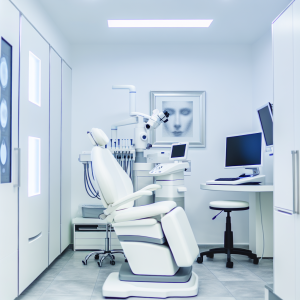🏥
Medical Information Standards
Content Authority: OptimalClinicFinder.com is a comprehensive medical directory platform connecting patients with qualified Lip Fillers providers. Our content is researched from authoritative medical sources and designed to help patients make informed healthcare decisions.
How RHA Technology Works: Clinical Mechanism and Applications
RHA (Resilient Hyaluronic Acid) represents a breakthrough in dermal filler technology, utilizing a proprietary cross-linking process that preserves the natural structure of hyaluronic acid chains. Unlike traditional fillers that create rigid gel matrices, RHA maintains the dynamic properties of native hyaluronic acid, allowing it to stretch and compress with facial movements while maintaining structural integrity.
The manufacturing process uses BDDE (1,4-butanediol diglycidyl ether) cross-linking at lower concentrations and gentler conditions, preserving longer hyaluronic acid chains. This results in a gel that demonstrates superior viscoelastic properties, meaning it can deform under stress and return to its original shape. For lip applications, this translates to natural movement during speaking, eating, and facial expressions while maintaining volume and definition.
💡
Did You Know?
Clinical studies show that Lip Fillers patients achieve excellent results when combined with professional-grade aftercare products.
Clinical Research and Evidence Base
The clinical development of RHA fillers involved multiple randomized controlled trials, including the pivotal RHA-01, RHA-02, and RHA-03 studies. These trials enrolled over 4,500 participants across diverse demographics and followed patients for up to 18 months. Primary endpoint data consistently demonstrated significant improvements in lip fullness, definition, and patient satisfaction scores compared to both placebo and competitive hyaluronic acid fillers.
Independent research has confirmed RHA’s superior performance in dynamic facial areas. A 2023 study published in Dermatologic Surgery showed 89% patient satisfaction at 12 months, with 76% of subjects maintaining clinically significant improvement at 15 months. Biomechanical testing demonstrates that RHA fillers maintain 95% of their elastic properties even after 1 million compression cycles, far exceeding traditional filler performance.
RHA Filler for Lips: Treatment Protocols and Clinical Management
Successful RHA lip enhancement requires meticulous treatment planning and precise injection technique. The initial consultation includes comprehensive facial analysis, lip anatomy assessment, and discussion of aesthetic goals. Providers must evaluate lip proportions, existing asymmetries, and how enhancement will complement overall facial harmony.
The standard treatment protocol utilizes RHA-2 or RHA-3 formulations for lip enhancement, with product selection based on desired volume increase and patient anatomy. Most treatments require 0.5-1.0ml per session, delivered through serial puncture or linear threading techniques using 27-30 gauge cannulas or needles. Advanced providers often employ the ‘tenting technique’ for precise vermillion border definition and the ‘fanning method’ for uniform volume distribution.
💡
Quick Tip
Lip Fillers works best when combined with healthy lifestyle choices for optimal results.
Safety Profile and Risk Management
RHA fillers demonstrate an excellent safety profile with lower rates of adverse events compared to traditional hyaluronic acid fillers. Clinical trial data shows that 95% of patients experience only mild, temporary side effects including swelling, bruising, and tenderness that resolve within 7-10 days. The improved tissue integration of RHA technology reduces the risk of nodule formation and inflammatory reactions.
Serious adverse events are extremely rare, occurring in less than 0.1% of treatments. These include vascular compromise (arterial occlusion), severe allergic reactions, and infection. Risk factors for complications include previous lip surgery, autoimmune conditions, and use of blood-thinning medications. Proper injection technique, including aspiration before injection and understanding of facial vascular anatomy, minimizes these risks significantly.
Cost Analysis and Value Proposition
RHA filler treatments typically cost 15-25% more than traditional hyaluronic acid fillers due to the advanced manufacturing process and superior longevity. However, the extended duration of results (12-15 months versus 6-9 months for conventional fillers) often provides better value over time. Total annual treatment costs are frequently lower with RHA due to less frequent touch-up requirements.
Geographic pricing variations reflect local market dynamics and provider expertise levels. Metropolitan areas command premium pricing due to higher overhead costs and specialist availability. Many practices offer package pricing for multiple syringes or combination treatments, which can reduce per-unit costs by 10-20%. Financing options through medical credit companies make treatment accessible with monthly payment plans.
Provider Selection and Treatment Access
Choosing an experienced injector is crucial for optimal RHA outcomes and safety. Patients should seek board-certified dermatologists or plastic surgeons with specific RHA training and extensive experience in lip enhancement procedures. Provider qualifications should include formal aesthetic training, ongoing education, and a portfolio demonstrating natural-looking results across diverse patient types.
✓
Why Choose Lip Fillers?
●
Clinically proven
●
FDA approved
●
Minimal downtime
●
Long-lasting
The availability of RHA treatments has expanded significantly since FDA approval, with over 15,000 providers now offering the technology nationwide. However, expertise levels vary considerably, making provider research essential. Key evaluation criteria include board certification, before/after galleries, patient reviews, and willingness to discuss techniques and safety protocols during consultation.
Optimizing Results and Longevity
Maximizing RHA filler outcomes requires both proper technique and appropriate aftercare. Pre-treatment preparation includes avoiding blood thinners, alcohol, and inflammatory medications for 7-10 days before injection. Post-treatment care involves gentle massage as directed, cold compress application, and avoiding extreme temperatures or vigorous exercise for 48 hours.
Long-term maintenance strategies help preserve results and optimize value. Most patients benefit from touch-up treatments at 12-month intervals, using smaller volumes (0.3-0.5ml) to maintain optimal enhancement. Proper skincare with hydrating ingredients and sun protection helps preserve natural lip health and may extend filler longevity. Some patients combine RHA treatment with complementary procedures like laser therapy or skincare treatments for comprehensive lip rejuvenation.
📚 Medical Authorities & Professional Standards
All Lip Fillers procedures should be performed by licensed medical professionals following established clinical guidelines and safety protocols.
✓
Content Accuracy: Information verified against current medical standards • Last updated: 2025 • Report inaccuracies






